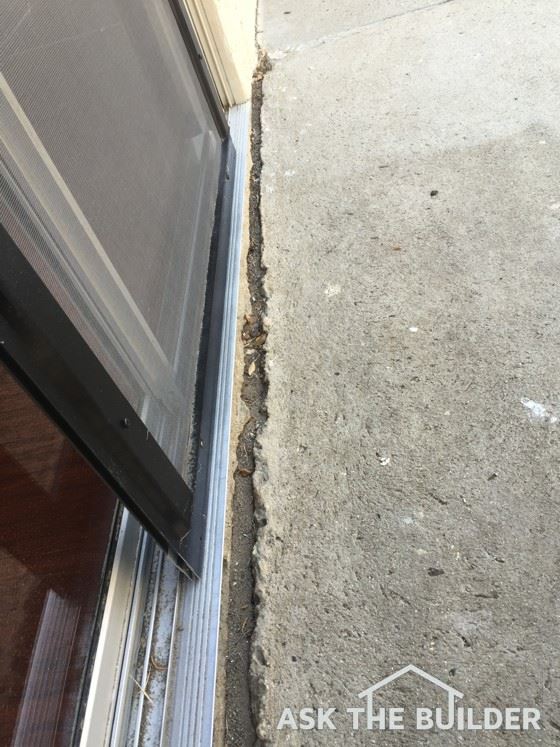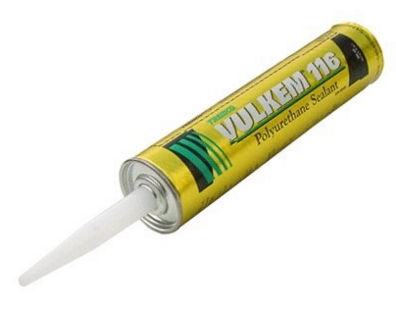Patio Slab Crack Repair

The unsightly gap to the right of the sliding screen door is supposed to be there. Photo Credit: Jeff Hileman
Patio Slab Crack Repair
DEAR TIM: I spent some time at your AsktheBuilder.com website but couldn’t locate the exact video that answers my question. There’s a wide ugly gap between my concrete outdoor patio slab and the slab my house is built on. I’m trying to determine whether to caulk the crack or fill it with some cement-based patching compound. There’s a lip on the patio that’s raised up. My guess is the concrete mix was soupy and the installers didn’t take the time to finish the slab correctly. Should I use a grinder to knock that down? How would you deal with this set of problems? Jeff H., Simi Valley, CA
DEAR JEFF: Thanks Jeff for checking out my videos! I’ve got hundreds there about lots of topics. I sat down one day and made a list of all the videos I’d love to tape. I discovered in a short amount of time that I could tape all day everyday until I die and not get five percent of the videos finished that need to be done. There are simply so many aspects of home building and maintenance that need to be covered in great detail with video.
I do have two videos at the website that got very close to answering your questions, so let’s start there. But before we do, let’s discuss the gap you’re wanting to fill and why it’s important that you do this job right.
In the building world, many of us call that gap an expansion joint. Concrete, like just about any other material, can expand and contract as the temperature goes up and down. Since the patio can receive direct sunlight and get rather hot during the day when the summer sun bakes it and the slab your home sits on is shaded, the two pieces of concrete expand and contract at different rates. If you keep the interior of your home at the same temperature throughout the year, your house slab is quite stable and static with respect to size.
It’s important that the gap between the two slabs be filled with a material that can absorb this motion, as slight as it might be. For this reason, forget about filling the gap with a hard repair compound that’s cement based. You need to fill it with something that’s flexible.
When installing a new slab against an existing one, many concrete masons put expansion joint material between the two slabs. Asphalt-saturated fiberboard was the staple expansion joint material of choice for years.
What I’d do if I were you is to clean out the gap to a depth of about 3 inches. I’d then use the caulk that the pros use on institutional and commercial buildings. These are normally not found at home centers.
Look for a hybrid urethane sealant that incorporates silane and end-capped polymer technology. Do an online search and you’ll discover these in minutes. Or CLICK HERE to buy it now. They come in a variety of colors. Once they cure, they produce a tenacious bond with the two concrete slabs.
It’s very important that you follow the directions to the letter when working with these caulks and sealants. I beg you to read the instructions on the label as well as any other printed literature that comes with the sealant.
You don’t fill the entire depth of the gap with the sealant or caulk. You’ll use a special foam backer rod that the sealant manufacturer recommends. Once again, use the exact backer rod that they say works best with their sealant. This ensures you’ll never have to do this repair again.
Getting the color to match is step one of making the gap look great. In two of my videos that you didn’t see I show a trick or two how to make cracks in blacktop and concrete disappear. It takes a little work, but it’s so worth it.
When I look at the photo of your patio slab that you sent me, I can clearly see some coarse sand particles in the concrete. You need to locate sand that’s got this same colored rock in it. Realize sand is just small tiny pieces of rock. Go to local sand suppliers and get a small bucket of sand that matches what you see in your slab.
I’d probably not grind off the high spot at the edge of the patio slab. I’d first try to use a wider cold chisel and knock off the highest points. This will make less dust and achieve the same goal.
Start filling the gap at the farthest corner where you don’t look so much at the gap. I want you to fill the gap as the sealant instructions say and only do about a foot of the gap. As soon as you get the sealant to the correct height, I want you to cover the caulk with a 1/8-inch layer of the dry sand. Carefully pat the sand into the caulk.
Stop working and allow the caulk or sealant to dry or cure. It could take 24 hours or more. Once you’re sure the sealant has hardened, then carefully brush off the excess sand and save it. Look to see if the joint is aesthetically pleasing. I can guarantee you it will look better than had you not put the sand onto the wet sealant. Adjust the amount of sand you apply to get the look you like.
Column 1124

One Response to Patio Slab Crack Repair